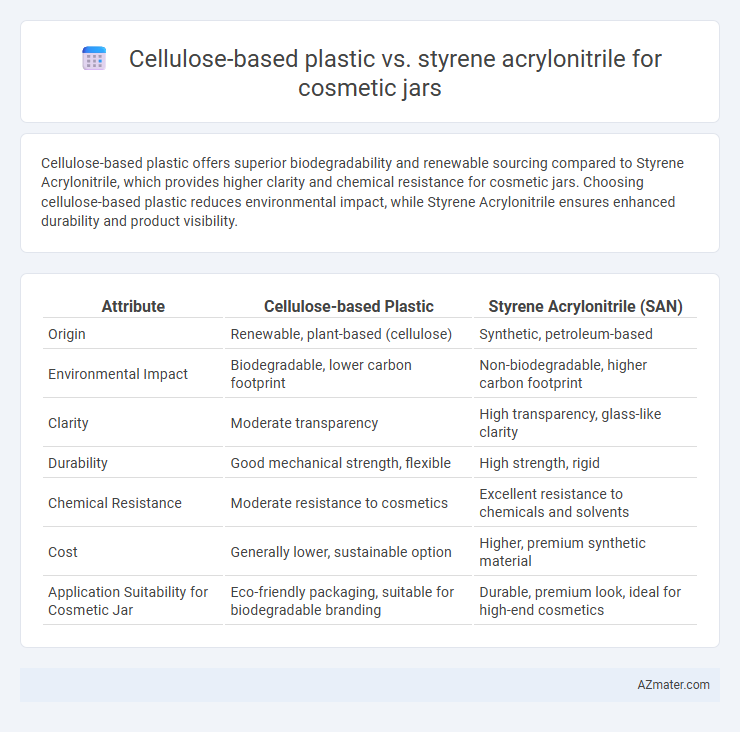Cellulose-based plastic offers superior biodegradability and renewable sourcing compared to Styrene Acrylonitrile, which provides higher clarity and chemical resistance for cosmetic jars. Choosing cellulose-based plastic reduces environmental impact, while Styrene Acrylonitrile ensures enhanced durability and product visibility.
Table of Comparison
| Attribute | Cellulose-based Plastic | Styrene Acrylonitrile (SAN) |
|---|---|---|
| Origin | Renewable, plant-based (cellulose) | Synthetic, petroleum-based |
| Environmental Impact | Biodegradable, lower carbon footprint | Non-biodegradable, higher carbon footprint |
| Clarity | Moderate transparency | High transparency, glass-like clarity |
| Durability | Good mechanical strength, flexible | High strength, rigid |
| Chemical Resistance | Moderate resistance to cosmetics | Excellent resistance to chemicals and solvents |
| Cost | Generally lower, sustainable option | Higher, premium synthetic material |
| Application Suitability for Cosmetic Jar | Eco-friendly packaging, suitable for biodegradable branding | Durable, premium look, ideal for high-end cosmetics |
Introduction to Sustainable Cosmetic Packaging
Cellulose-based plastic offers a biodegradable and renewable alternative to traditional Styrene acrylonitrile (SAN) in cosmetic jars, reducing environmental impact through compostability and reduced fossil fuel dependency. SAN provides durability and chemical resistance but relies on petrochemical sources, contributing to plastic pollution and longer degradation times. Adopting cellulose-based plastics supports sustainable cosmetic packaging initiatives by enhancing eco-friendliness and aligning with circular economy principles.
Overview of Cellulose-Based Plastics
Cellulose-based plastics, derived from renewable plant fibers such as wood pulp or cotton, offer a sustainable alternative to traditional petroleum-based materials like Styrene acrylonitrile (SAN) in cosmetic jars. These bioplastics provide excellent biodegradability, reducing environmental impact while maintaining mechanical strength and clarity comparable to SAN. Their compatibility with cosmetic formulations and customizable barrier properties make cellulose-based plastics increasingly favored for eco-friendly packaging solutions.
What is Styrene Acrylonitrile (SAN)?
Styrene Acrylonitrile (SAN) is a copolymer made from styrene and acrylonitrile, known for its clarity, toughness, and chemical resistance, making it a popular choice for cosmetic jars. Compared to cellulose-based plastic, SAN offers superior transparency and rigidity, providing an attractive display while protecting cosmetic contents from damage. Its resistance to oils, fats, and solvents enhances product safety and longevity, crucial for high-quality cosmetic packaging.
Environmental Impact: Cellulose-Based Plastic vs SAN
Cellulose-based plastic for cosmetic jars offers superior biodegradability and lower carbon footprint compared to Styrene Acrylonitrile (SAN), which relies on petrochemical sources and is not readily biodegradable. The production of cellulose-based plastics utilizes renewable biomass, reducing overall greenhouse gas emissions and dependence on fossil fuels, whereas SAN contributes to long-term environmental pollution through microplastic persistence. Recycling cellulose-based plastics is more sustainable, promoting compostability and reducing landfill accumulation, while SAN recycling is limited and often results in downcycling or landfill disposal.
Durability and Performance Comparison
Cellulose-based plastics offer biodegradability and moderate durability suitable for eco-friendly cosmetic jars but may exhibit lower impact resistance and chemical stability compared to styrene acrylonitrile (SAN). SAN provides superior performance with high resistance to impact, heat, and chemical solvents, ensuring long-term integrity and protection of cosmetic formulations. Choosing between these materials depends on the balance between sustainability priorities and the required durability for cosmetic jar applications.
Aesthetic and Design Flexibility
Cellulose-based plastic offers a natural matte finish and excellent transparency, enhancing the aesthetic appeal of cosmetic jars through a warm, eco-friendly look that resonates with sustainable branding. Styrene acrylonitrile (SAN) provides superior design flexibility with its high gloss, rigidity, and ability to be easily molded into complex shapes, allowing for sleek, modern cosmetic jar designs with sharp details. The contrast between cellulose-based plastic's organic texture and SAN's polished clarity enables brands to choose materials that best align with their desired visual identity and consumer experience.
Cost Analysis and Market Availability
Cellulose-based plastics for cosmetic jars typically incur higher production costs due to raw material expenses and complex processing compared to styrene acrylonitrile (SAN), which benefits from lower manufacturing costs and established production infrastructure. Market availability of SAN is broader, with extensive supply chains and widespread industry adoption, whereas cellulose-based plastics remain less prevalent, often limited to niche or eco-conscious brands. Cost-efficiency and widespread market presence make SAN a more accessible choice, while cellulose-based plastics are favored for sustainable alternatives despite premium pricing.
Barrier Properties: Protecting Cosmetic Products
Cellulose-based plastics offer superior oxygen and moisture barrier properties, effectively preserving the integrity of cosmetic products by minimizing oxidation and contamination. Styrene acrylonitrile (SAN) provides good chemical resistance but has comparatively lower barrier performance against gases and vapors, potentially compromising product freshness. Choosing cellulose-based plastic ensures enhanced protection for sensitive formulations, extending shelf life and maintaining cosmetic efficacy.
Consumer Perception and Brand Value
Cellulose-based plastic in cosmetic jars is increasingly favored for its biodegradability and association with sustainability, enhancing brand value among eco-conscious consumers. Styrene acrylonitrile (SAN) offers superior clarity and durability, appealing to consumers prioritizing product aesthetics and longevity, but may face criticism due to its petroleum-based origin. Brands leveraging cellulose-based containers often gain a competitive edge by aligning with environmental values, while SAN jars maintain appeal through premium appearance and perceived product protection.
Future Trends in Cosmetic Jar Materials
Cellulose-based plastics are gaining traction in cosmetic jar production due to their biodegradability and renewable sourcing, aligning with the increasing demand for sustainable packaging solutions. Styrene acrylonitrile (SAN) remains popular for its clarity, durability, and chemical resistance, but faces challenges from environmental regulations and consumer preference shifts. Future trends indicate a strong move towards bio-based polymers like cellulose derivatives that offer eco-friendly alternatives without compromising aesthetic appeal and functional performance in cosmetic jars.

Infographic: Cellulose-based plastic vs Styrene acrylonitrile for Cosmetic jar
 azmater.com
azmater.com